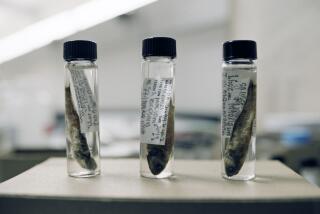Mexico Agrees to Phase Out 2 Highly Toxic Pesticides
- Share via
WASHINGTON — Mexico agreed Friday to virtually end its use of DDT and chlordane, two highly toxic pesticides that are severely restricted in the United States but enter this country in border-crossing mists, waterways and wildlife.
DDT is banned in the United States, and chlordane can be used only under limited circumstances.
The agreement is a triumph for environmental advocates who have been crusading for years against the chemicals, which were once commonly used. It also reflects what has become a continuing effort in the United States and Canada to help Mexico chip away at long-festering environmental problems.
The action was announced at a meeting in Pittsburgh of U.S., Mexican and Canadian officials monitoring provisions of the North American Free Trade Agreement.
At one time, as much as 1,500 tons of DDT was used annually in Mexico. Up to 100 tons of the insecticide is still being used there each year to kill mosquitoes that carry malaria.
“DDT is bad stuff, and it travels long distances,” said William Nitze, the assistant administrator of the U.S. Environmental Protection Agency who was closely involved in the negotiations.
“They’re already way down,” he said of Mexico’s use of DDT. “We’re going to help them finish the job.”
Under the new accord, Mexico will aim to phase out 80% of its DDT within five years and end all use of it 10 years later, Nitze said. He added: “We’re going to try to speed that up.”
Also under the plan, chlordane’s use will be phased out in five years. The chemical kills fire ants and termites and is used mainly in Mexico’s southern states.
The three nations also pledged to continue an already established program under which states and provinces will make public the release into the atmosphere and waterways of toxic chemicals.
There has been no structure in place under which residents of communities in the United States can easily determine what pollutants are being dispersed by factories and utilities located across international borders.
The program will coordinate and set standards for the release of data by the three countries.
“What we need to do is help Mexico improve their capacity to measure [toxic] releases,” Nitze said in an interview.
“These action plans are a regional response to growing local and international concern over the detrimental impact of these toxic substances on human health and the environment,” officials for the three nations said in a statement. “Implementing these action plans will also contribute to the reduction of long-range transport of air pollutants to the Arctic.”
DDT was once used worldwide, but its links to reproductive problems in birds and its classification by the EPA as a probable cancer-causing agent for humans led to the U.S. ban in 1972. Canada followed suit in 1985.
Traces of the chemical can travel thousands of miles and can accumulate in fatty tissues in the food chain. It is found in some of its greatest concentrations in colder climates, where it remains longer before being broken down.
The elimination of DDT in Mexico will be accomplished by the draining of marshes and other bodies of water where mosquitoes breed. In addition, DDT and chlordane--considered moderately toxic and a probable human carcinogen--will be replaced by other chemicals.
“We are now looking at a number of substitutes. Some are quite expensive,” said Jose Luis Samaniego, an official of Mexico’s Ministry of Environment, Natural Resources and Fisheries.
The United States will provide technical advice and the additional assistance of several EPA experts, Nitze said.
Chlordane has been unavailable for residential use in the United States since 1987. Canada banned it outright in 1995.
More to Read
Sign up for Essential California
The most important California stories and recommendations in your inbox every morning.
You may occasionally receive promotional content from the Los Angeles Times.










